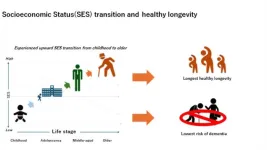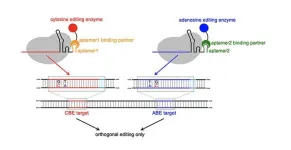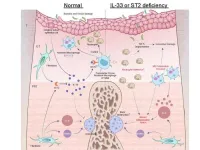Recent developments at MD Anderson offer insights into biomarkers that predict immunotherapy responses, a possible treatment strategy for patients with LKB1-deficient cancers, therapeutic targets to prevent acute myeloid leukemia (AML) progression in patients with p53 mutations, a novel drug-delivery system to cross the blood-brain barrier, the use of acupuncture to manage radiation-induced dry mouth, targets for improving severe side effects from immunotherapy, a faster sequencing method for detecting somatic mutations, an approach to boost cervical cancer screening rates among Black and Hispanic women in Texas, and an automated method for integrating cross-platform data for patients with rectal cancer.
Study catalogs comprehensive list of proofreading mutations in POLE gene to better predict immunotherapy responses
The POLE enzyme copies DNA but can also ‘proofread’ and cut out any mistakes in this process. Mutations in the POLE gene are being investigated as potential biomarkers to help predict immunotherapy responses, but there is ongoing debate about which specific mutations are truly predictive. Giulia Maddalena, M.D., Fadl Zeineddine, M.D., John Paul Shen, M.D., and colleagues developed a novel method to detect the signature of mutated DNA when POLE is unable to proofread. Screening 1,358 unique POLE mutant alleles from a pan-cancer cohort of 46,332 patients, they generated a comprehensive list of the 30 POLE mutant alleles that cause loss of proofreading (LOP) and predict benefit from immunotherapy. Whereas tumors with any of the non-LOP mutations are not expected to have improved immunotherapy outcomes, this study provides a valuable resource to efficiently identify patients most likely to benefit from immunotherapy. Learn more in Annals of Oncology.
Understanding ferroptosis regulation points to potential treatment strategies for LKB1-deficient cancers
Ferroptosis – a type of cell death induced by uncontrolled lipid peroxidation – is a known tumor suppression mechanism, but its underlying regulation remains incompletely understood. The mitochondrial electron transport chain (ETC) complex I protein is associated with generating superoxide radicals, but mitochondrial activity has been shown to paradoxically both induce and suppress ferroptosis. To provide further insights, Boyi Gan, Ph.D., and colleagues examined the role of ETC complex I on ferroptosis. Inhibiting ETC complex I reduces ubiquinol levels while activating AMPK, which are known to either promote or suppress ferroptosis, respectively. Consequently, the effect of complex I inhibitors on ferroptosis is limited. AMPK inhibition or LKB1 removal effectively sensitized cancer cells to ferroptosis induced by ETC complex I inhibitors. Inhibition of ETC complex I also boosted radiotherapy to suppress LKB1-deficient tumor growth, highlighting the therapeutic potential of ferroptosis-inducing strategies for patients with LKB1-deficient cancers. Learn more in Molecular Cell.
Age-specific induction of mutant p53 drives clonal hematopoiesis and AML
Acute myeloid leukemia (AML) with p53 mutations is notoriously resistant to existing therapies. Therefore, researchers led by Rasoul Pourebrahim, M.D., Ph.D., and Michael Andreeff, M.D., Ph.D., investigated the complex role of p53 mutations in hematopoietic stem cells (HSCs).The researchers generated the first preclinical models of p53-mutant clonal hematopoiesis to explore the molecular mechanisms of AML development and progression, particularly in the context of aging and genetic variations. By genetically reducing Mdm2 levels in these models, they demonstrated a new role for Mdm2 in regulating myeloid lineage commitment and cholesterol biosynthesis, highlighting it as a critical factor in the transformation of myeloid HSCs to age-related AML. The interaction between aging, Mdm2 and AML provides new insights into disease mechanisms and suggests potential early therapeutic targets to prevent the development of AML in patients with p53 mutations. Learn more in Cell Reports Medicine.
Novel drug-delivery system uses cerebral blood flow to improve brain targeting
Many brain-related diseases are difficult to treat due to the challenges of delivering drugs across the blood-brain barrier. Vinpocetine is a natural compound that enhances cerebral blood flow and has a protein structure that can become positively charged, allowing it to more easily interact with the negatively charged transporters and channels in the barrier. Vinpocetine also has a high capacity for the loading and delivery of nucleic acid drugs. Leveraging this, Wen Jiang, M.D., Ph.D., and colleagues developed a brain-targeting delivery system called vinpocetine-derived ionizable-lipidoid nanoparticles (VIP). The VIP mechanism selectively regulates cerebral blood flow to improve intracellular transport and drug delivery without significant inflammation and with less toxicity than standard nanoparticle delivery systems. The study highlights the potential of using vinpocetine and other alkaloid natural products for precision medicine, while the novel VIP system could ensure these drugs safely and effectively reach targets in the brain. Learn more in Nature Communications.
Acupuncture reduces radiation-induced dry mouth for head and neck cancer patients
Patients with head and neck cancer who receive radiation treatment often suffer from xerostomia, or persistent dry mouth, which negatively impacts their daily lives. To find new options for these patients, researchers led by Lorenzo Cohen, Ph.D., conducted a Phase III randomized trial on 258 patients evaluating the effectiveness of acupuncture in managing chronic radiation-induced xerostomia (RIX) compared with a sham control and standard oral hygiene. The study showed that acupuncture improved RIX symptoms and overall quality of life (QOL) after four weeks compared to standard oral hygiene, as assessed through a xerostomia questionnaire and a QOL survey. These findings suggest that clinical care guidelines should be revised to incorporate acupuncture as a recommended treatment for RIX. Learn more in JAMA Network Open.
Study identifies potential treatments for severe immunotherapy side effects
While immune checkpoint therapy is effective at triggering antitumor responses in many patients, it also can cause life-threatening complications, such heart and skeletal muscle inflammation. However, the molecular mechanisms and immune cell subsets responsible for these toxicities are largely unknown. Researchers led by Padmanee Sharma, M.D., Ph.D., and Sumit Subudhi, M.D., Ph.D., examined samples from patients who experienced these side effects to understand their underlying causes. The study identified specific immune pathways, including a unique group of IL-1B+ myeloid cells. This is the first identification of these myeloid subsets in human immune-related heart and skeletal muscle inflammation, offering potential targets to improve outcomes for patients facing these serious immunotherapy complications. Learn more in Cancer Immunology Research.
Novel algorithm achieves breakthrough speed in identifying genetic alterations in tumors
Somatic mutation calling is a computational method to identify genetic alterations in a tumor by comparing genomic sequences from a matched tumor and a normal patient sample. Researchers led by Wenyi Wang, Ph.D., improved their previous somatic mutation calling algorithm by developing a high-speed version called MuSE 2.0, which incorporates improved memory allocation and parallel computing. Their new algorithm resulted in speeds eight to 80 times faster than existing approaches while maintaining superior accuracy. This advancement allows for rapid analysis of whole-genome sequencing data, facilitating research across multiple cancer cohorts. MuSE 2.0 is freely accessible and has the potential to make significant strides in cancer genomics research. Learn more in Genome Research.
Education and at-home HPV tests improve cervical cancer screening rates in Texas
In Texas, Black and Hispanic women have lower cervical cancer screening rates along with higher incidence and mortality rates than national averages. Possible reasons include lack of access to affordable services, lack of information, and cultural or language barriers. To address this, researchers led by Surendranath Shastri, M.B.B.S, M.D., Ph.D., provided culturally competent educational intervention and distributed human papillomavirus (HPV) self-sampling kits to Black and Hispanic women. Of 115 screening-eligible Houston-based participants, 40 agreed to use HPV self-sampling tests following an education program. Screening improved from 65% to 91% in Black participants and from 66% to 96% in Hispanic participants. This study provides proof-of-concept that culturally relevant knowledge and access to cervical screening among racial and ethnic minorities improves screening uptake and could reduce incidence and mortality among this patient population. Learn more in JCO Global Oncology.
Automated cross-platform data integration developed for rectal cancer patients
The introduction of targeted therapies, immunotherapies and molecular biomarkers has led to larger patient data sets, with increasing challenges to integrate data from various platforms and utilize them effectively for large-scale oncology applications. To address this, researchers led by John Paul Shen, M.D., and Abhineet Uppal, M.D., developed an automated method for extracting, integrating and validating cross-platform oncology data in patients undergoing treatment for rectal cancer. Using this system, the researchers extracted demographic, clinicopathologic, tumor mutation, radiographic and treatment data from the electronic health records of 516 patients. The platform achieved improved accuracy for various data categories, including tumor and lymph node classifications, as well as chemotherapy and radiation therapy data. The study demonstrates the potential of automated data integration to enhance efficiency in clinical research and optimize patient outcomes. Learn more in JCO Clinical Cancer Informatics.
Awards and honors
Yu Shen, Ph.D., chair ad interim of Biostatistics, was named Fellow of the Institute of Mathematical Statistics (IMS) In case you missed it
Read below to catch up on recent MD Anderson press releases.
End-of-life systemic treatment for patients with advanced cancers does not improve survival Pre- and post-surgical immunotherapy improves outcomes for patients with operable lung cancer Read this press release in the MD Anderson Newsroom.
- 30 -
END




